This unique lemongrass and rhubarb cheesecake is beautifully fragrant with infused grassy citrus lemongrass and a stunning red rhubarb streak inside. (Jump directly to the recipe.)
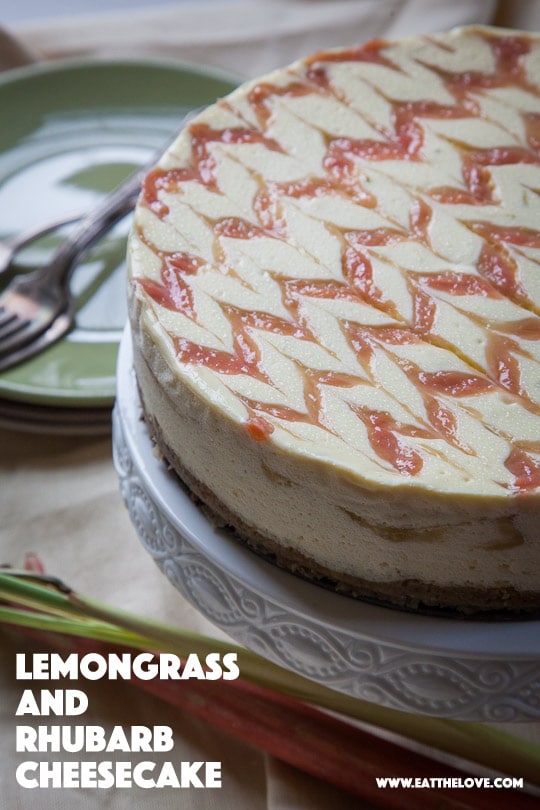
About 15 years ago my brother called me up asking for a favor. He had moved from Missouri to do a fellowship at UC Davis in forensic psychology. It was suppose to be a two-year temporary move, after which he was planning on moving back to Missouri to be with his then girlfriend (now wife). At the end of the fellowship, he had a graduation dinner with his advisor and his girlfriend was scheduled to fly out to join him. Disaster struck when his girlfriend’s car broke down on the way to the airport (she lived in the middle of the state, about 2 hours away from the closest major airport). She couldn’t make it to his dinner.
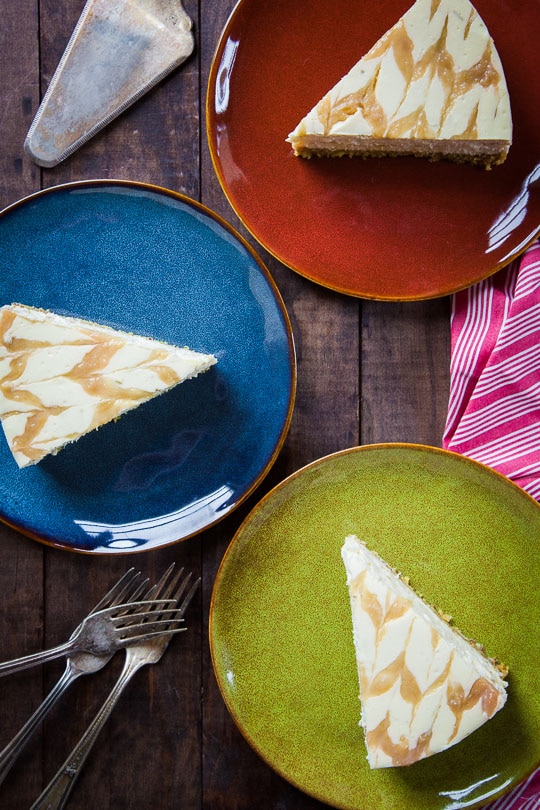
My brother called me up last minute and told me he had plans at a fancy restaurant but since she wasn’t able to make it, could I come in her place? The restaurant was a little farther away, in Napa, so I might have to borrow or rent a car. But he didn’t want to just bring anyone since it was a fancy restaurant and a graduation celebration. I would have to figure out what to wear a suit as well as there was a dress code at the restaurant. I said I was happy to join him. What was the restaurant? He replied back “I think it’s called French Laundry? Something like that.” I told him I’d go with him but he owed me big time for the last minute filling in.
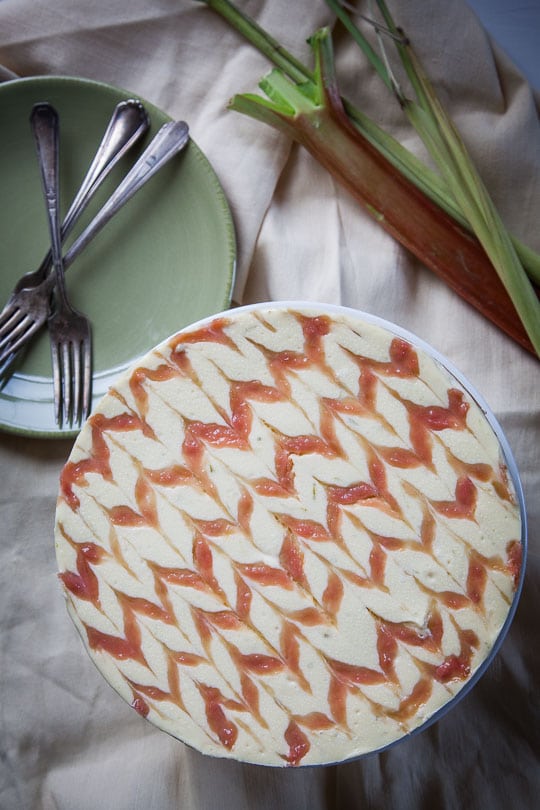
Of course, if it isn’t evident, my brother knows very little about food. I went and enjoyed myself immensely, knowing I was eating at one of the best restaurants in the country. And though the entire meal was memorable, I specifically remember that one of the dessert courses was a lemongrass panna cotta, something I had never had before, never even thought existed. So when my friend Peter asked me to make a dessert for his Passover dinner, I decided to take inspiration from that meal from so long ago and make a lemongrass and rhubarb cheesecake. Like that fancy restaurant in Napa, it didn’t disappoint.
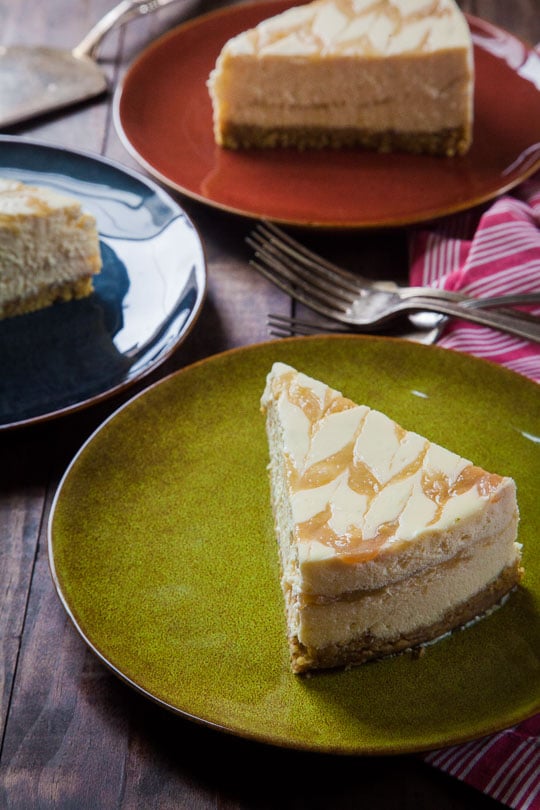
Lemongrass and Rhubarb Cheesecake
By Irvin Lin
If you’ve never used lemongrass before, it may seem daunting. Long and woody, lemongrass seems like an odd thing to use in a dessert. I infuse milk with chopped lemongrass and then use it in the cheesecake. The result is a delicate grassy citrus creamy cheesecake that marries well with the tart rhubarb. For a more pronounced lemongrass flavor, make the infused milk the day before, and let it sit overnight in the refrigerator. This original recipe was designed to be Kosher for Passover (but not pareve) but I’ve also included more common ingredients for everyone who wants to bake it anytime or for those who aren’t following a KoP diet.
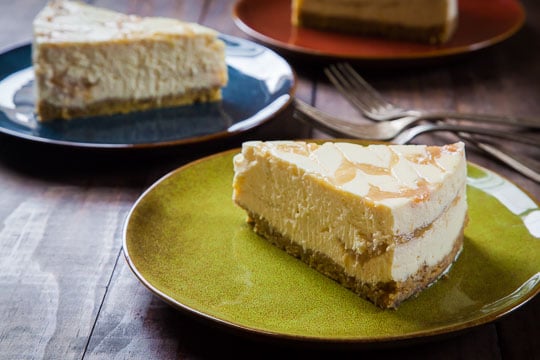
Ingredients
Lemongrass cheesecake filling
2 stalks lemongrass, roughly chopped
1 cup whole milk
32 ounces (4 packages or 905 g) cream cheese, at room temperature
3/4 cup (150 g) white granulated sugar
zest from 1 lime
4 large eggs
2 teaspoon lime juice
Crust
2/3 cup (95 g) pistachio nuts, out of the shell
1/2 cup (100 g) matzo cracker crumbs or graham cracker crumbs
1/3 cup (67 g) white granulated sugar
1/4 teaspoon kosher salt
5 tablespoons (70 g) melted unsalted butter
Rhubarb filling
1/2 pound (225 g) rhubarb, chopped into 1/2-inch chunks
2 tablespoons water
4 tablespoons white granulated sugar, divided
1-inch fresh ginger, peeled and grated
2 tablespoons tapioca starch or cornstarch
Directions
1. Place the lemongrass and milk in a small saucepan and heat until bubbles start to form on the side of the pan. Cover and remove from heat. Let the lemongrass steep for 30 minutes at room temperature or up to 8 hours overnight in a fridge.
2. Once the milk has steep, preheat the oven to 350ºF. Lightly spray a 9-inch springform pan with cooking oil. Place two large sheets of aluminum foil on a table, crisscrossing each other. Place the springform pan in the middle of the foil and then wrap the foil up and around the side of the pan.
3. Make the crust by placing the pistachios in a food processor or blender. Pulse until the nuts are broken down into small bits. Add the cracker crumbs, sugar and salt into the processor or blender bowl. Pulse a few times to blend, then drizzle the butter into the dry ingredients with the machine on. Stop when the crust starts to clump up. Dump into the prepared pan and press the crumbs with your finger (or the back of a spoon) evenly into the bottom. Bake in the oven until the crust starts to smell fragrant, about 8 to 10 minutes. Remove from the oven and let cool on a wire rack. Reduce the oven temperature to 300ºF.
4. Make the rhubarb filling by placing the rhubarb, water and 2 tablespoons of the sugar in small saucepan. Cook over medium heat until the rhubarb starts to fall apart, about 5 to 8 minutes. Add the remaining sugar, grated ginger and tapioca starch or cornstarch. Return to heat and cook until thickened, about 2 minutes. Remove from heat and set aside to cool.
5. Make the lemongrass filling by placing the cream cheese, sugar and lime zest in the bowl of a stand mixer fitted with a paddle attachment. Strain out the lemongrass from the milk into a glass measuring cup, discarding the solids. You should have 2/3 cup. If you have less, add a little regular milk until you have enough. If you have too much, discard the remaining milk. Mix the cream cheese together with the other ingredients until fluffy, about 1 to 2 minutes. Add the eggs, one at a time, waiting for each to incorporate before adding the next one. Add the lime juice and beat until incorporated.
6. Pour 1/2 the lemongrass cheesecake filling into the pan over the crust and carefully spread it over the bottom of the pan. Spoon most of the rhubarb filling over the cheesecake filling, reserving about 3 to 4 tablespoons for the top. Carefully spoon the remaining lemongrass filling over the rhubarb filling and smooth it out.
7. Place the reserve rhubarb filling in a freezer resealable bag, and seal it. snip a corner of the bag off with scissors and pipe parallel lines of the rhubarb filling over the top of the cheesecake filling. Drag a toothpick in one direction perpendicular over the rhubarb lines, then in the opposite direction, switching directions back and forth over the rhubarb lines to create a “chevron” pattern. Place the pan in a large roasting pan and fill the pan halfway up with boiling water.
8. Bake the cheesecake until the edges of the cheesecake starts to barely puff up and turn slightly brown, about 45 to 50 minutes. The center of the cheesecake will still be wobbly but it will firm up when it cools. Turn the oven off and crack the oven door slightly to cool the inside but don’t remove the pan from the oven. Let the cheesecake cool in the roasting pan until the water is at room temperature, about an hour. Remove from water, discard the foil and let the cheesecake cool on a wire rack for another 2 hours or until the bottom of the pan doesn’t feel warm anymore. Cover the pan with aluminum foil and refrigerate overnight or for at least 8 hours.
9. Serve directly from the refrigerator or let it sit at room temperature for an hour before serving for a less firm texture.
Make 1 9-inch cheesecake, serves 12.

heather (delicious not gorgeous) says
*just* the french laundry. nbd.
Kathleen M. says
Sounds lovely ! Forr us, non-americans… how many grams creamcheese would this take ?
Thanks, Kathleen
Shannon Parrott says
Hello! Can you help me modify the recipe in two respects: no nuts in the crust (a friend is allergic to all nuts) and cooking time if I bake the cheesecake in several individual mini pots…
also tips (if baking in mini pots) to keep from cracking…?!
Irvin says
Hello! So you can easily swap out the nuts to more graham cracker or matzo meal. Just use a total of 1 1/4 cups of graham cracker crust or matzo meal. If you live in the UK, and graham crackers aren’t available, digestive biscuits will work as a substitution.
As for tips on the baking in the mini pots, you want to start the oven at 300°F / 150C / gas mark 2. It depends on how large the mini pot is, but start checking your oven about 15 minutes into the baking? Maybe less if you are using really small pots or are baking with a muffin tin. Bake until the middle of the cheesecakes wiggle just a bit. They will continue to cook from the residual heat and then firm up as they cool. Turn the oven off and crack the door a bit to let the cheesecakes slowly cool. Abrupt heat change will also make the cheesecake crack, as the outside of the cake will cool faster than the inside part, which leads to stress and cracking.
I hope this helps!